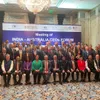Digital payments market will hit triple trillions of dollars by 2026
Asia's booming digital payment market is expected to hit trillions of dollars by transaction value in 2030, ballooning threefold over a decade earlier, as more fintech and digital banks emerge from the best-funded segment in the region, according to a new Google-led study.
In a span of just six years, India, primarily a cash-based economy, now leads the world in real-time digital payments, accounting for almost 40 per cent of all such transactions. The mass adoption of UPI during the COVID-19 pandemic has extended far beyond the urban to even rural India, an effect that left the experts in amazement.
In a country witnessing rapid growth, it comes as no surprise that India also has one of the fastest-growing fintech landscapes in the world, driven by the advancement in digital payments segment. A recent report by PhonePe and Boston Consulting Group concluded that India's digital payments market will more than triple from $3 trillion to $10 trillion by 2026.
In line with this, the use of digital payments continues to be promoted so that each citizen of the country can access digital payment facilities that are affordable, convenient and secure. The introduction of innovative reforms and technological advancements are further accelerating growth at an unprecedented pace.
When one thinks digital payments, UPI - India's payment gateway - instantly comes to mind. The Unified Payments Interface (UPI) has been the flag-bearer of India's fintech revolution - launched in 2016 by the National Payments Corporation of India (NPCI).
The UPI is an instant real-time payments system that enables inter-bank peer-to-peer and person-to-merchant transactions through mobile devices instantly.
In Southeast Asia, it has become a battleground for digital payment companies, with Western players like Amsterdam-based Adyen and San Francisco- and Dublin-headquartered Stripe becoming bigger players in the region. Stripe began service in Thailand this week, having entered Singapore and Malaysia in recent years.
The region's internet economy is projected to reach $330 billion in 2025, down from last year's forecast for $363 billion. This was the first time the report cut the forecast, said Davis of Google, pointing to the impact of global supply chain disruptions last year.
By country, Indonesia continued to lead as the largest digital economy in Southeast Asia. There, online spending is forecast to rise to $130 billion by 2025, followed by Thailand, Vietnam, the Philippines, Malaysia and Singapore.
According to a forecast by the International Monetary Fund (IMF), Vietnam's economy will rise to the third position in the ASEAN region by 2025 with a GDP of about $570 billion.
That means in 2025, the digital economy will reach a value of about $114 billion, or 20 per cent of $570 billion. This is an extremely large number, showing the great potential in digital transformation and the digital payment field for all businesses.
In addition, the Government has licensed Mobile Money with the expectation that mobile money services will be popular in cities and can reach remote and rural areas.
The most recent is payment services using QR codes. This is the story of financial universalisation not only in the city, big markets and supermarkets but also in night markets and tourist areas in rural and remote areas. The use of QR code payment methods has the support of the internet and mobile phones.





